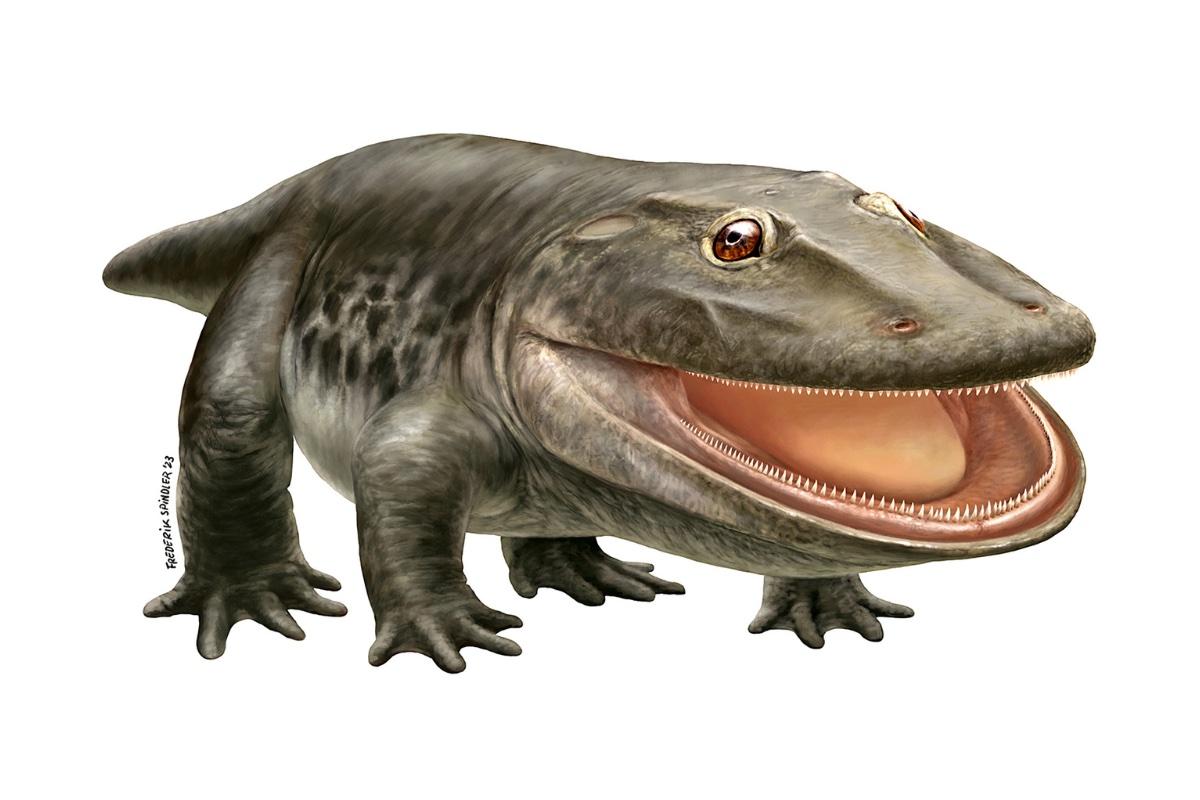An international team of researchers with participation from the Museum für Naturkunde Berlin has discovered a new species of early tetrapod in the Rotlegend between Kaiserslautern and Trier in western Rhineland-Palatinate, Germany. The animal, named Stenokranio (Greek: stenos + kranio = "narrow skull") after its special head shape, lived almost 300 million years ago and was one of the largest predators of its time.
The new species Stenokranio boldi was up to one and a half meters long, had a large, flat skull with several pointed teeth and fed on fish and other tetrapods. It is an extinct representative of the Temnospondyli, a group of amphibians that was particularly rich in species in ancient times. As an amphibian, the animal was able to live in water and on land. In the palate, Stenokranio had three pairs of large, backward-curving fangs that were used to hold onto slippery prey such as fish.
Long before the emergence of crocodiles, the amphibian Stenokranio lived as a lurking hunter in and on the edge of tropical waters. In terms of body shape and lifestyle, the animal occupied a similar ecological niche as the later crocodiles, although it is more closely related to extant frogs and salamanders than to crocodiles.
Stenokranio is part of the oldest well-documented prehistoric community in Europe, which comes from the Remigiusberg near Kusel in the West Palatinate. So far, remains of three other species of early tetrapods (Cryptovenator hirschbergeri, Remigiomontanus robustus, Trypanognathus remigiusbergensis) have been described from the Remiguisberg fossil deposits, whose closest relatives were native to what is now the southwest of the USA and Thuringia.
The discovery of this top predator is an important new piece of the mosaic in our picture of the diversity and interrelationships of long-extinct creatures in the lakes and rivers of the late Paleozoic in Central Europe. It enables comparisons with similar habitats in Europe and the US. The Remigiusberg site with its mainly aquatic amphibians represents the ideal counterpart to the contemporaneous layers of the Bromacker in Thuringia, which the Museum für Naturkunde Berlin is researching in a cooperation project with partners. So far, only amphibians and other tetrapods that were adapted to life on land have been found there.
Facts about Stenocranio boldi
How big and heavy could the animals get?
It is estimated that Stenocranio could grow up to 1.5 meters long. Its closest relative, Eryops megacephalus from the US, reached skull lengths of up to 60 centimeters and body lengths of up to three meters. The body weight of the large American animals is estimated at 160 kilograms. The largest known specimen of Stenokranio may have had a live weight of up to 70 kilograms.
Where did the animal live? How should one imagine its habitat?
During Stenokranio's lifetime, the Palatinate was near the equator and was part of a huge (100 x 300 kilometer) mountain valley that stretched from Lorraine to Frankfurt am Main and from the Hunsrück almost to Karlsruhe. The mountain valley (geologically: Lorraine-Saar-Nahe basin) was a tropical river and lake landscape. In the area of today's Remigiusberg, a large river flowed into a lake about 70 kilometers long. Stenokranio lived on the banks of this lake or in the delta of the river in question.
How did the animal live?
Stenokranio occupied the ecological niche of crocodiles, which appeared much later in the Mesozoic era. It was an amphibian that could live in water and on land. The reproduction took place in water. The young animals will have lived predominantly in water, the adults in water and on land. Stenokranio was a fish-eater and a carnivore that was likely to have stalked its prey as a lurking predator in shallow water and on the banks of lakes and rivers. Alongside early mammalian precursors such as the carnivorous pelycosaurs, Stenokranio was one of the largest known predators of its time. The design of its jaws did not allow for cutting (or chewing) prey. Prey was grabbed, held in the roof of the mouth with the pointed teeth and enlarged fangs, and probably swallowed more or less whole.
Publication
Werneburg, R., Witzmann, F., Rinehart, L., Fischer, J. & Voigt, S. (2024): A new eryopid temnospondyl from the Carboniferous-Permian boundary of Germany. – Journal of Paleontology, doi: 10.1017/jpa.2023.58.
